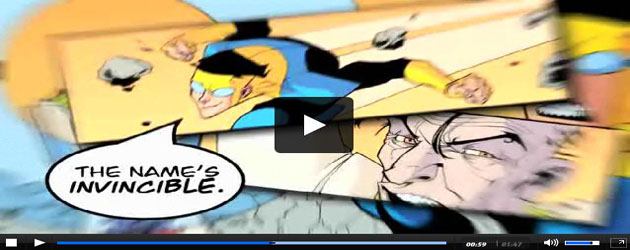It’s nice when the name of a thing tells you exactly what that thing is and exactly what that thing does, such as dishwasher or garage door opener or toothbrush. We in the wordsmith business like to call these self-explanatory terms, which itself is a self-explanatory term…OK, digression time is over.
Today we are going to talk about the motion comic.
A hybrid of sorts, motion comics are not quite animation and they are not quite stop-motion (obviously), and they are certainly not anime. They are and should be in a category all by themselves.

OK, so now that you know, or at least have some idea, of what motion comics are not, it is time to talk about what they are. As the name implies, motion comics are simply comic book images set to motion.
Let’s examine this a little deeper, shall we? Of course we shall.
The on-screen images in most motion comics look like they were literally ripped out of a comic book and thrown in front of a camera or on the glass top of a scanner. It is at this point in the process, however, that the motion comic sheds the cocoon of conventions encasing its brothers and sisters in the sequential art medium and becomes something different, something unique and exciting, something with infinite possibilities just waiting to be fleshed out by insightful, creative artists.
One fairly established formula motion comics creators use as a sort of outline is to take the stiff, froze-in-a-pose images, and lay the audio track down to serve as a figurative pathway for the story to follow. The audio typically consists of dialog between the characters, individual characters’ thoughts or narrations, and scene setting or enhancing music. The images are then manipulated in such a way as to match the scene on the screen.
If you have ever read digital comic books and graphic novels online, then you don’t have too far to go to imagine what a motion comic looks like. The reason motion comics are not the same as animation, is that the characters and backgrounds do not move their bodies or mouths like cartoons and anime characters typically do to simulate the physical actions, reactions, and mannerisms of real world living beings.
Where did it come from?
It is tempting to assume that motion comics are a new addition to the genre of storytelling via the mediums of artwork combined with text, usually in the forms of narration and quotation. But we all know what happens when we assume, right? Motion comics have been on the scene (pun intended) since the early days of the new millennium. One of the first examples of a motion comic is Broken Saints, an independently created and developed series that was released in 2001 and contained 24 episodes. Some argue that the motion comic form came out of a novel entitled The Zap Gun, written by iconic visionary Philip K. Dick way back in the 1960s.
DC Comics is recognized as the company that really got the motion comics ball rolling. They are also credited with coining the term “motion comic.” Since DC Comics is a subsidiary of Warner Bros., its initial motion comics offerings were produced and presented as a sort of opening band thrown out on the stage to whip the crowd into a frenzied madness before the headliners take the stage, which in this case were the 2008 and 2009 super mega behemoth blockbuster movies The Dark Knight and Watchmen.
Perhaps in order to keep pace with their nemesis, Marvel comics has dipped its metaphorical toe into the creative pool of motion comics. Once they noticed that the water was warm and cozy, Marvel wasted no time proving they were serious about becoming major players in the motion comic game by introducing adaptations of Astonishing X-Men, created under the watchful eyes of Joss Wedon and John Cassaday, and the Brian Michael Bendis, Alex Maleev produced Spider-Woman series in 2009.
Kevin P. Hanson
kevin@comicattack



Pingback: Online research | Transition of Comic Art